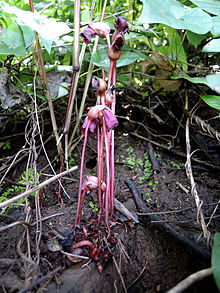| Aeginetia indica | |
|---|---|

| |
| Forest ghost flower, Aeginetia indica | |
| Scientific classification | |
| Kingdom: | Plantae |
| Clade: | Tracheophytes |
| Clade: | Angiosperms |
| Clade: | Eudicots |
| Clade: | Asterids |
| Order: | Lamiales |
| Family: | Orobanchaceae |
| Genus: | Aeginetia |
| Species: | A. indica |
| Binomial name | |
| Aeginetia indica Linnaeus, 1753 | |
Aeginetia indica, commonly known as Indian broomrape or forest ghost flower, is a holoparasitic herb or root parasite of the plant family Orobanchaceae. It grows in moist deciduous and semi-evergreen forests of tropical and subtropical Asia and New Guinea. It parasitises plants of the families Cannaceae, Commelinaceae, Cyperaceae, Juncaceae, Poaceae, and Zingiberaceae.
In many regions, including the Nepal Eastern Himalayas, Aeginetia indica is used for medicinal and ritual purposes. For example, the entire plant is placed in shrines or on altars during the Teej festival as a symbol of Shiva and Parvati.
References
- English Names for Korean Native Plants (PDF). Pocheon: K noorea National Arboretum. 2015. p. 343. ISBN 978-89-97450-98-5. Archived from the original (PDF) on 25 May 2017. Retrieved 25 January 2016 – via Korea Forest Service.
- Aeginetia indica. In: Plants of the World Online London, Kew.
- Aeginetia indica (forest ghost flower), Vélez-Gavilán J, 2019. Invasive Species Compendium. Wallingford, UK
- "Forest Ghost Flower". FlowersofIndia.net. Retrieved 14 Jan 2014.
- "Aeginetia indica". Orowiki. Archived from the original on December 21, 2011. Retrieved 14 Jan 2014.
- O'Neill, Alexander; Rana, Santosh (2017-07-16). "An ethnobotanical analysis of parasitic plants (Parijibi) in the Nepal Himalaya". Journal of Ethnobiology and Ethnomedicine. 12 (14): 14. doi:10.1186/s13002-016-0086-y. PMC 4765049. PMID 26912113.
This Orobanchaceae article is a stub. You can help Misplaced Pages by expanding it. |